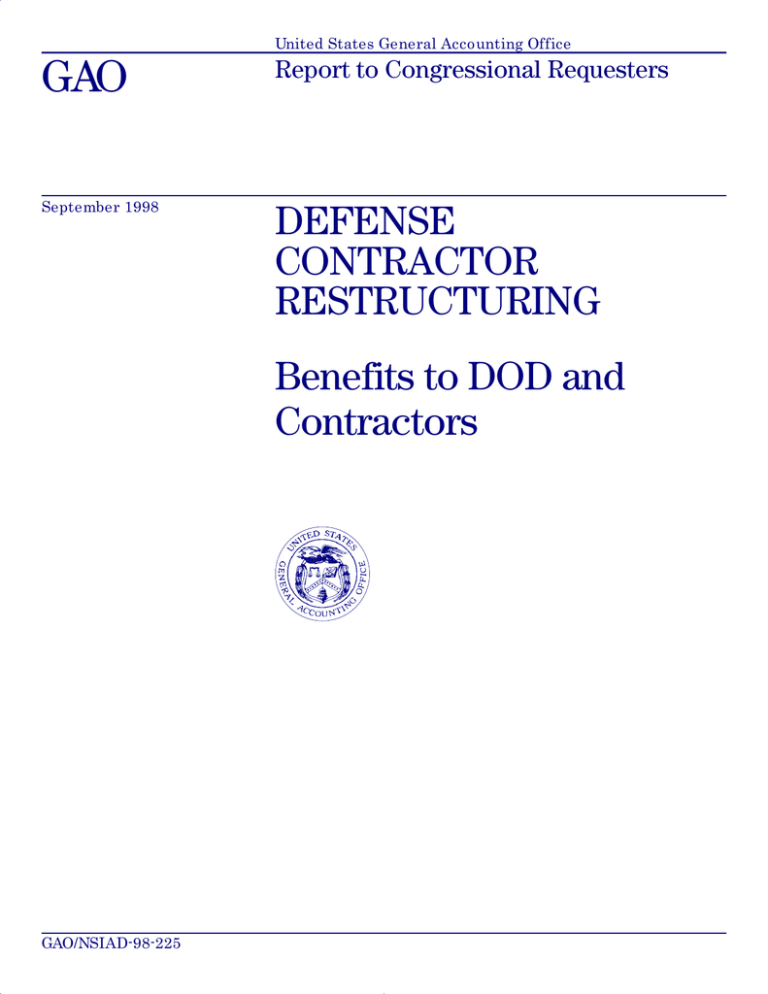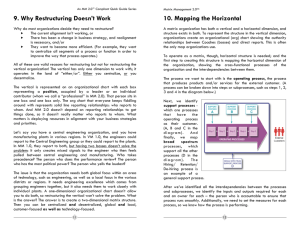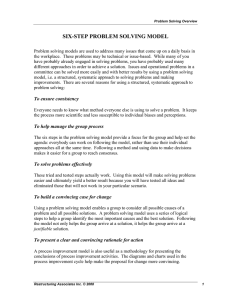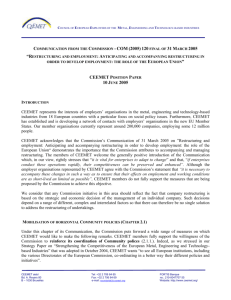GAO DEFENSE CONTRACTOR RESTRUCTURING
advertisement

United States General Accounting Office GAO Report to Congressional Requesters September 1998 DEFENSE CONTRACTOR RESTRUCTURING Benefits to DOD and Contractors GAO/NSIAD-98-225 GAO United States General Accounting Office Washington, D.C. 20548 National Security and International Affairs Division B-278554 September 10, 1998 The Honorable Charles E. Grassley United States Senate The Honorable Peter A. DeFazio The Honorable Carolyn B. Maloney The Honorable Bernard Sanders The Honorable Christopher H. Smith House of Representatives As a result of declining defense expenditures, contractors have been consolidating and restructuring their operations to reduce costs through activities such as disposing of facilities, combining operations and systems, relocating workers and equipment, and reducing workforce personnel. As you requested, we reviewed seven defense contractor business combinations to determine whether the Department of Defense (DOD) is realizing savings as a result of such restructuring activities. Specifically, we (1) identified the amount of restructuring savings expected by DOD from the seven business combinations, (2) assessed the impact of selected restructuring activities on the contractors’ cost of operations, and (3) determined if savings could be traced to contract prices. Our report is based on data from 10 individual contractor business segments, including at least 1 segment from each of the 7 business combinations. Background To encourage defense contractor consolidations, DOD announced in July 1993 that it would pay for restructuring costs on transferred flexibly priced contracts in certain circumstances.1 These circumstances were that (1) the restructuring costs were allowable under the Federal Acquisition Regulation and (2) a DOD contracting officer determined that the business combination was expected to result in overall reduced costs to DOD or preserve a critical defense capability. Concerns over the payment of restructuring costs led Congress in 1994 to pass section 818 of Public Law 103-337, requiring that certain conditions be met before DOD could reimburse defense contractors for 1 After a business combination, contracts are transferred from one contractor to another through written agreements executed by the seller, buyer, and government. These agreements cite the government’s approval to transfer its contracts. Flexibly priced contracts are those under which the total amount paid to the contractor depends on the allowable costs the contractor incurs in performing the work. Page 1 GAO/NSIAD-98-225 Defense Restructuring Savings B-278554 restructuring-related expenses. The legislation required that a senior DOD official certify that projections of restructuring savings were based on audited cost data and that the projected savings should result in overall reduced costs to DOD. The legislation also required the Secretary of Defense to report annually to Congress on DOD’s experience with defense contractor business combinations, including whether savings associated with each restructuring actually exceeded restructuring costs. In 1996, Congress passed section 8115 of Public Law 104-208, which stipulated that for business combinations occurring after September 30, 1996, projected savings had to (1) be at least twice the amount of costs allowed or (2) exceed the costs allowed, provided the Secretary of Defense determined that the combination would result in the preservation of a critical capability. In November 1997, section 804 of Public Law 105-85 made these requirements permanent. None of the seven business combinations we examined were subject to the two-to-one ratio requirement because they occurred before this requirement was established. We have issued several products on defense contractor restructuring. See Related GAO Products for specific references. Results in Brief For the seven business combinations we reviewed, DOD expects that it will save about $3.3 billion from contractor restructuring activities, such as laying off workers, closing facilities, and relocating employees and equipment. Our assessment of selected restructuring activities showed that they had lowered the cost of operations at the seven business combinations by hundreds of millions of dollars. Such reductions benefited DOD because the costs of defense contracts were lower than they would have been if the restructuring activities had not occurred. Determining the precise impact of restructuring on specific contract prices requires isolating the impact of these activities from nonrestructuringrelated factors, such as changes in business volume, quantities purchased, and accounting practices. DOD, selected business segments, and we were generally not able to isolate the effects of restructuring from those of other factors. Page 2 GAO/NSIAD-98-225 Defense Restructuring Savings B-278554 Expected Restructuring Savings Table 1: Projected Restructuring Savings expects that it will save $3.3 billion between 1993 and 2000 as a result of restructuring activities carried out by the seven business combinations we examined. Table 1 shows total projected restructuring savings and DOD’s share of these savings for each of the seven business combinations. DOD Dollars in millions DOD sharea Total savings Gross savings Net savings $832.9 $505.8 $373.3 United Defense Limited Partnership 110.8 79.7 50.6 Martin Marietta - General Electric Aerospace 524.1 305.4 149.1 Northrop - Grumman - Vought 440.2 263.4 216.7 Martin Marietta - General Dynamics Space Systems Division 196.6 139.6 88.9 4,224.8 2,675.8 2,269.9 211.5 148.1 113.1 $6,540.9 $4,117.8 $3,261.6 Business combination Hughes - General Dynamics missile operationsb Lockheed - Martin Marietta Hughes - CAE-Link Total Note: With the exception of Hughes - General Dynamics, all savings figures reflect the values used in DOD’s certification decision. a Restructuring savings are allocated to all of the contractors’ customers; accordingly, DOD’s share of savings will depend on its share of the contractors’ business base. Net savings are DOD’s gross savings less its share of restructuring costs. b Because the Hughes - General Dynamics combination occurred before the requirement for DOD to certify that savings will exceed costs, Hughes did not initially prepare a comparable figure for total restructuring savings. The total amount and DOD share of savings associated with this combination reflect a March 1997 estimate prepared by Hughes. We derived the net savings by subtracting Hughes’ original cost estimate from its March 1997 savings estimate. As part of the process to ensure that expected restructuring savings exceed projected costs, DOD regulations require contractors to submit a proposal that includes details on planned restructuring activities, projected costs, and anticipated savings. The regulations do not require contractors to propose or demonstrate savings on individual contracts or use any particular method or approach in estimating restructuring savings. As a result, the seven business combinations used a variety of estimating methods. These methods included Page 3 GAO/NSIAD-98-225 Defense Restructuring Savings B-278554 • • • • • estimating the savings on eight contracts and subsequently extrapolating the estimate across the contractor’s entire business base (over 1,000 contracts), comparing incurred costs at two companies before their combination with the projected costs at the restructured company, computing average salary and fringe benefits for employees to be laid off due to restructuring activities and multiplying these averages by up to 5 years, estimating reductions in operational costs from closing facilities and disposing of equipment, and projecting the impact that transferring work from the acquired company had on the overhead costs charged to the acquiring company’s existing or anticipated contracts. The Defense Contract Audit Agency’s (DCAA) guidance on reviewing restructuring proposals states that the contractor is responsible for establishing and supporting the reasonableness of the restructuring savings estimates.2 In April 1998, we reported that the broad framework provided under this guidance may result in DOD accepting proposed savings that are not directly attributable to restructuring.3 We noted that our work at Lockheed Martin’s Space & Strategic Missiles sector indicated that some of the operational improvements and their associated savings could have been accomplished without restructuring. Subsequently, we found that Lockheed Martin did not fully consider the impact of normal downsizing activities when estimating restructuring savings. For example, Lockheed Martin attributed 1,153 support personnel reductions at its Missiles & Space segment in 1995 to restructuring activities. However, before its merger with Martin Marietta was complete, Lockheed had forecasted that its total personnel level at this segment would decrease by 849 in 1995. Because Lockheed Martin did not consider reductions that were already planned, the amount of savings that was directly attributed to restructuring for 1995 may be overstated by $170 million.4 Lockheed Martin officials pointed out that this amount would not have affected DOD’s 2 DCAA is responsible for auditing contractors’ restructuring proposals and providing a report on the results of its audit to the Defense Contract Management Command’s (DCMC) contracting officers. 3 This report also noted that DCAA’s guidance may not provide sufficient criteria to evaluate restructuring savings, particularly those that may have been achieved without restructuring. Although we recommended that DOD clarify DCAA guidance on evaluating restructuring savings, DOD did not believe any changes to the guidance were needed. 4 Lockheed’s estimate did not identify how many of the 849 persons that were expected to leave in 1995 were support personnel. We estimated this number by (1) taking the ratio of support personnel to total personnel that actually left in 1995 (57.2 percent) and (2) multiplying this ratio by 849. We then multiplied the resulting figure by the contractor’s estimate of the average monthly salary and fringe benefit costs to determine the overstated amount. Page 4 GAO/NSIAD-98-225 Defense Restructuring Savings B-278554 decision to pay restructuring costs because of the large amount of projected savings from the business combination. realizes benefits from restructuring when its contract prices are lower than they would have been if restructuring had not occurred. The price of a typical government contract consists of indirect and direct costs.5 Restructuring activities that reduce indirect costs generally result in lower forward pricing rates and lower contract prices.6 Similarly, restructuring activities that reduce direct costs will be reflected in contract prices in the form of lower costs for such elements as direct labor or material costs. Five of the contractor business segments we visited included only indirect cost reductions in their estimated restructuring savings, whereas the other five segments included both direct and indirect cost reductions. DOD Restructuring Activities Lowered Contractors’ Operating Costs Restructuring activities have enabled contractors to reduce their projected operating costs by hundreds of millions of dollars. The following four examples illustrate how restructuring enabled reductions in projected operating costs: • The Hughes - CAE-Link business combination led to closing most of CAE-Link’s Binghamton, New York, operations and terminating 548 employees. The projected savings resulting from these activities—about $212 million—was computed by taking the total operating costs of the segments of the two companies that were to be combined and comparing that amount with the projected operational costs after restructuring.7 For example, in the year before restructuring, the two segments had combined operating costs of $195.3 million. Hughes subsequently projected that the operating costs for these segments would decrease to about $161.9 million in the first year of restructuring and about $150.8 million annually for the next 4 years. We verified that these lower costs were reflected in Hughes’ 5 Indirect costs, also called overhead costs, cover general business costs such as depreciation, maintenance, and general office expenses that are applicable to a contractor’s business. These costs are allocated to all contracts. Conversely, direct costs are associated with a specific program or contract and are charged directly to that program or contract. Examples of direct costs include expenses for engineering and manufacturing labor, subcontractors, and raw materials. 6 Forward pricing rate agreements are used by DOD and defense contractors to facilitate the pricing of contracts. Contractors typically project the amount of indirect costs that are expected to be incurred over the next several years and then compute forward pricing or overhead rates, which are generally stated in percentages. To price a contract, the rates are applied against the contract’s direct cost elements to estimate the amount of overhead costs to be allocated to that contract. If no changes have occurred in the contractor’s projected business base, restructuring activities that reduce indirect costs will result in lower forward pricing rates. Applying these lower rates to the contract’s direct cost elements will result in a lower contract price. 7 The savings figures used throughout this section refer to total estimated restructuring savings. Page 5 GAO/NSIAD-98-225 Defense Restructuring Savings B-278554 • • • Impact of Restructuring on Contract Prices Is Difficult to Determine forward pricing rates that were made available to DOD contracting officers to price contracts. For the Northrop - Grumman - Vought business combination, we reviewed proposed savings from reductions in corporate overhead costs. After the business combination, several restructuring activities were undertaken, including closing Grumman’s headquarters in Bethpage, New York. Northrop Grumman estimated that closing this facility would save about $215 million over a 5-year period. About $100 million of the savings represented the labor and fringe benefit costs associated with laying off approximately 250 workers. Consequently, the amount of corporate overhead costs allocated to Northrop Grumman’s B-2 bomber program was less after restructuring than it would have been if restructuring had not occurred. After its acquisition of General Electric Aerospace, Martin Marietta restructured the operations of its Electronics & Missiles segment, thereby reducing projected overhead costs by $101 million over a period of about 5 years. The reductions consisted of (1) $68 million for vacating facilities, consolidating activities, eliminating jobs, and obtaining concessions in property taxes; (2) $18 million in concessions for employee wages and benefits, water, sewage, and electricity charges; (3) $11 million for relocating data processing activities and personnel; and (4) about $4 million in concessions in long-distance telephone rates. We traced these savings into the contractor’s overhead expense pools and its forward pricing rates. The lower rates were made available to DOD contracting officers to price contracts. After the merger of Lockheed and Martin Marietta, Lockheed Martin’s Missiles & Space business segment restructured its operations, including reducing overhead and support personnel and consolidating various administrative functions.8 As a result, the contractor was able to reduce its projected indirect labor costs by $739 million. Lockheed Martin reflected these indirect labor cost reductions in its August 1996 forward pricing rates. Determining the impact that restructuring activities had on a contract price requires isolating the effect of restructuring from nonrestructuringrelated factors, such as changes in quantities or improvements in manufacturing efficiencies. In its annual reports to Congress, DOD has acknowledged that other factors, such as inflation, business fluctuations, accounting system changes, and subsequent reorganizations, also impact the contractors’ overall cost of operations. DOD noted that it is not feasible 8 Some of the personnel reductions may have been due to normal downsizing rather than restructuring. Page 6 GAO/NSIAD-98-225 Defense Restructuring Savings B-278554 to precisely isolate the impact of restructuring from the impact of these other factors. Our work substantiates DOD’s position. United Defense provided the clearest example of a contract price reduction related to restructuring. For a fixed-price foreign military sales contract for self-propelled howitzers, the contracting officer had included a “reopener” clause,9 requiring the contractor to reduce the contract price after restructuring its operations. The contracting officer negotiated a $1.8 million reduction—or about 4 percent—to the contract’s $48.5 million price.10 This reduction was negotiated based on a proposal developed by the contractor that showed the impact of restructuring on the contract. Contractors offered other examples that they believed demonstrated how contract prices were affected by restructuring. However, we were unable to isolate the impact of restructuring from the impact that other factors had on the contract prices. For example, our analysis of Hughes Aircraft Company contract data showed the Army purchased 12,600 Tube-launched Optically-tracked Wire-guided (TOW) antiarmor missiles at an average unit price of $16,800 before restructuring and 8,758 TOW missiles at a unit price of $15,677 after restructuring in 1993. Despite the 30-percent decrease in quantities, the average unit price of the missile was $1,123, or almost 7 percent, lower after restructuring. Hughes officials attributed the reduction in part to lower overhead rates after Hughes’ acquisition of General Dynamics’ missile operations. However, Hughes officials pointed out that other factors, such as changes in quantities and production rates, learning curve efficiencies, and fluctuations in business volume, also affected the unit price of the missile. Neither we nor the contractor could isolate the effect of restructuring from the influence of these other factors on the unit price. After its acquisition of General Electric Aerospace, Martin Marietta officials provided information showing that the Navy purchased 25 test equipment items at a unit price of $1,270,524 before restructuring and 25 of the same test equipment items at a unit price of $1,246,230 after restructuring. Even though the unit price was $24,294 lower after restructuring, we could not isolate the impact of restructuring from the 9 A reopener clause permits a downward-only price adjustment to a fixed-price contract whose price did not reflect the impact of restructuring. Once the contractor has determined the impact of restructuring, DOD can use the clause to reduce the price of that contract and thereby recoup its share of restructuring savings. 10 In our July 1998 report, we pointed out that, despite repeated recommendations from DCAA and DCMC personnel, contracting officers rarely included reopener clauses in contracts awarded before contractors incorporated estimated restructuring savings into their forward pricing rates. Page 7 GAO/NSIAD-98-225 Defense Restructuring Savings B-278554 influence of other factors, such as learning curve improvement and business volume changes. Contractor officials believe the reduction is attributable in part to restructuring activities but acknowledged that the other factors also affected the unit price. Similarly, United Defense’s unit price for refurbishing the Bradley Fighting Vehicle was between 8 and 16 percent lower after restructuring than before restructuring. The unit price range is primarily due to differences in the number of items to be refurbished and the inflation rate used to adjust the unit price before restructuring. Army procurement officials believe the lower unit price resulted from both restructuring and normal downsizing, whereas contractor officials believe most of the reduction resulted from restructuring. Lockheed Martin officials reported that restructuring after the Martin Marietta - General Dynamics Space Systems Division combination resulted in significant savings to the Air Force’s Titan launch vehicle program. After the combination, Martin Marietta closed General Dynamics’ San Diego-area manufacturing facilities and relocated the Atlas and Centaur launch vehicle programs to its Titan production facility in Denver. According to contractor officials, producing all three launch vehicles in Denver enabled Martin Marietta to eliminate redundant engineering, manufacturing, and quality assurance personnel. Contractor officials reported that these activities resulted in a total of $223 million in reductions to the estimated cost to complete three Titan contracts. These reductions—which ranged between 3.7 and 5.6 percent of the cost to complete the contracts—were reflected in various contractor cost performance reports submitted to the Air Force. Titan program officials agreed that restructuring reduced projected program costs but noted that it was not possible to precisely quantify the impact of restructuring separate from the impact of other factors. The officials explained that a number of changes were occurring concurrently on the Titan program, including a reduction in the number of launch vehicles and the implementation of various acquisition reform initiatives. Contract prices may not always be lower after restructuring, even though DOD benefited from restructuring. For example, the Northrop - Grumman Vought business combination reduced the amount of corporate overhead costs being charged to the B-2 bomber program. We estimated that the B-2’s general and administrative overhead rate—to which corporate overhead costs are allocated—was about 1 percent less than it would have been if restructuring had not occurred. Nevertheless, the B-2’s general and Page 8 GAO/NSIAD-98-225 Defense Restructuring Savings B-278554 administrative overhead rate rose significantly from 1993 to 1996, principally due to decreases in the planned procurement of B-2s. Consequently, the nonrestructuring-related changes to the B-2 program more than offset the benefit of restructuring. In another case, even though savings from restructuring activities contributed to a 7-percent reduction in the 1993 unit price of the TOW missile, the 1994 unit price of $19,498 was actually $3,821 more than the 1993 unit price of $15,677. Although restructuring savings associated with the acquisition of General Dynamics’ missile operations led to a lower amount of overhead costs being applied to the contract, our analysis indicates that increases in material and armament subcontract costs that were unrelated to restructuring more than offset restructuring savings. Agency Comments In commenting on a draft of this report, DOD concurred with our findings. DOD’s comments are provided in appendix I. The Aerospace Industries Association (AIA) provided comments on our report on behalf of the business combinations we reviewed. AIA stated that the report objectively and fairly attempted to trace restructuring savings to individual programs or contracts. AIA’s comments are provided in appendix II. Scope and Methodology To identify the amount of restructuring savings expected by DOD, we identified each of the business combinations for which DOD had certified that estimated restructuring savings should exceed projected restructuring costs. As of June 1, 1998, DOD had issued nine certifications associated with six business combinations: • • • • • • United Defense Limited Partnership, a joint venture between FMC Corporation’s Defense Systems Group and Harsco Corporation’s BMY Combat Systems Division; Martin Marietta Corporation’s acquisition of General Electric Company’s aerospace and other business segments; Martin Marietta’s acquisition of General Dynamics Corporation’s Space Systems Division; Northrop Corporation’s acquisitions of the Grumman Corporation and the Vought Aircraft Company to form the Northrop Grumman Corporation; the merger of the Lockheed Corporation and Martin Marietta to form the Lockheed Martin Corporation; and Hughes Electronics’ acquisition of CAE-Link Corporation. Page 9 GAO/NSIAD-98-225 Defense Restructuring Savings B-278554 To determine the amount of savings expected for each of these business combinations, we reviewed the information prepared during DOD’s certification process, including the contractor’s restructuring proposal, DCAA audit reports, negotiation memorandums, and other pertinent information. We also reviewed restructuring savings associated with Hughes Aircraft Company’s August 1992 acquisition of General Dynamics’ missile operations. Even though this business combination occurred before the requirement for DOD to certify that savings should exceed costs, DOD included the estimated savings and costs in its reports to Congress on defense industry restructuring. Hughes did not initially prepare an estimate of total expected savings that was audited by DCAA. Consequently, we used data that was submitted to DOD by Hughes in March 1997 that projected the overall impact of restructuring activities. This data was subjected to a limited review by DCAA, which tested the mathematical accuracy of cost and savings computations and assessed the reasonableness of the contractor’s estimating methods. For each business combination, we also obtained updated information on estimated restructuring savings from the cognizant DCMC offices and reviewed DOD’s reports to Congress on defense industry restructuring. To assess the impact of restructuring activities on the contractors’ operational costs, we reviewed restructuring activities at 10 contractor business segments, including at least 1 segment from each business combination. We generally selected those business segments with the largest projected amount of restructuring savings. These 10 segments were expected to generate about $2.4 billion, or over 70 percent, of the projected $3.3 billion in net savings to DOD. We did not attempt to validate that the reported restructuring savings were directly attributable to restructuring activities. We used multiple approaches to determine if restructuring had reduced the contractors’ cost of operations. At Northrop Grumman, where a large part of projected restructuring savings were generated at the corporate level, we reviewed the corporate overhead costs to its B-2 business segment to determine if such charges were lower after restructuring. At other locations that proposed indirect cost reductions, we determined how such estimates were developed and whether such reductions had been reflected in overhead cost accounts. Page 10 GAO/NSIAD-98-225 Defense Restructuring Savings B-278554 In assessing whether restructuring savings could be traced to contract prices, we determined if DOD contracting officers had included downward-only reopener clauses in fixed-price contracts negotiated before the contractors had adjusted their forward pricing rates to reflect the impact of restructuring. For those contracts containing such clauses, we determined whether the contracting officer had exercised the clause and, if so, the amount by which the contract’s price was reduced. For contractors whose savings reflected reductions in indirect costs, we tried to compare the overhead rates that were in effect before restructuring with the rates that were in effect after restructuring. We also determined whether such rates were made available to contracting officers to price contracts. For those contractors that included direct costs as restructuring savings, we examined contract-related documents to determine if these costs were less than before restructuring. In addition, we requested that contractor officials identify comparable items that DOD purchased before and after restructuring. We accepted the items the contractors identified and did not make an independent evaluation to determine whether they identified all available comparable items. We compared the prices DOD paid for these items before and after restructuring to determine if the prices had been impacted by restructuring or other factors. Finally, we discussed the results of our analyses with officials from the business combinations, DOD, DCMC, and DCAA. We performed our work between May 1997 and July 1998 in accordance with generally accepted government auditing standards. Unless you publicly announce its contents earlier, we plan no further distribution of this report until 7 days after its issue date. At that time, we will send copies of this report to the Secretary of Defense; the Commander, DCMC; the Director, DCAA; the Director, Office of Management and Budget; and interested congressional committees. Copies will also be made available to others upon request. Page 11 GAO/NSIAD-98-225 Defense Restructuring Savings B-278554 Please contact me at (202) 512-4841 if you or your staff have any questions concerning this report. Major contributors to this report are listed in appendix III. David E. Cooper Associate Director Defense Acquisitions Issues Page 12 GAO/NSIAD-98-225 Defense Restructuring Savings Page 13 GAO/NSIAD-98-225 Defense Restructuring Savings Contents Letter 1 Appendix I Comments From the Department of Defense 16 Appendix II Comments From the Aerospace Industries Association 17 Appendix III Major Contributors to This Report 18 Related GAO Products 20 Table Table 1: Projected Restructuring Savings 3 Abbreviations AIA DCAA DCMC DOD TOW Page 14 Aerospace Industries Association Defense Contract Audit Agency Defense Contract Management Command Department of Defense Tube-launched Optically-tracked Wire-guided GAO/NSIAD-98-225 Defense Restructuring Savings Page 15 GAO/NSIAD-98-225 Defense Restructuring Savings Appendix I Comments From the Department of Defense Page 16 GAO/NSIAD-98-225 Defense Restructuring Savings Appendix II Comments From the Aerospace Industries Association Page 17 GAO/NSIAD-98-225 Defense Restructuring Savings Appendix III Major Contributors to This Report National Security and International Affairs Division, Washington, D.C. John K. Harper Timothy J. DiNapoli Paula J. Haurilesko John D. Heere Atlanta Field Office George C. Burdette Erin B. Baker Beverly A. Breen Los Angeles Field Office Dorian R. Dunbar Kenneth H. Roberts Thaddeus S. Rytel, Jr. San Francisco Field Office Ruth-Ann Hijazi Donald Y. Yamada Page 18 GAO/NSIAD-98-225 Defense Restructuring Savings Page 19 GAO/NSIAD-98-225 Defense Restructuring Savings Related GAO Products Defense Contractor Restructuring: DOD Risks Forfeiting Savings on Fixed-Price Contracts (GAO/NSIAD-98-162, July 17, 1998). Defense Industry Restructuring: Updated Cost and Savings Information (GAO/NSIAD-98-156, Apr. 30, 1998). Defense Industry Restructuring: Clarification of Cost and Savings Issues (GAO/NSIAD-97-186R, June 17, 1997). Defense Industry Restructuring: Cost and Savings Issues (GAO/T-NSIAD-97-141, Apr. 15, 1997). Defense Restructuring Costs: Information Pertaining to Five Business Combinations (GAO/NSIAD-97-97, Apr. 1, 1997). Defense Restructuring Costs: Projected and Actual Savings From Martin Marietta Acquisition of GE Aerospace (GAO/NSIAD-96-191, Sept. 5, 1996). Defense Contractor Restructuring: First Application of Cost and Savings Regulations (GAO/NSIAD-96-80, Apr. 10, 1996). Defense Restructuring Costs: Payment Regulations Are Inconsistent With Legislation (GAO/NSIAD-95-106, Aug. 10, 1995). Overhead Costs: Defense Industry Initiatives to Control Overhead Rates (GAO/NSIAD-95-115, May 3, 1995). Defense Industry Consolidation: Issues Related to Acquisition and Merger Restructuring Costs (GAO/T-NSIAD-94-247, July 27, 1994). (707249) Page 20 GAO/NSIAD-98-225 Defense Restructuring Savings Ordering Information The first copy of each GAO report and testimony is free. Additional copies are $2 each. Orders should be sent to the following address, accompanied by a check or money order made out to the Superintendent of Documents, when necessary. VISA and MasterCard credit cards are accepted, also. Orders for 100 or more copies to be mailed to a single address are discounted 25 percent. Orders by mail: U.S. General Accounting Office P.O. Box 37050 Washington, DC 20013 or visit: Room 1100 700 4th St. NW (corner of 4th and G Sts. NW) U.S. General Accounting Office Washington, DC Orders may also be placed by calling (202) 512-6000 or by using fax number (202) 512-6061, or TDD (202) 512-2537. Each day, GAO issues a list of newly available reports and testimony. To receive facsimile copies of the daily list or any list from the past 30 days, please call (202) 512-6000 using a touchtone phone. A recorded menu will provide information on how to obtain these lists. For information on how to access GAO reports on the INTERNET, send an e-mail message with "info" in the body to: info@www.gao.gov or visit GAO’s World Wide Web Home Page at: http://www.gao.gov PRINTED ON RECYCLED PAPER United States General Accounting Office Washington, D.C. 20548-0001 Official Business Penalty for Private Use $300 Address Correction Requested Bulk Rate Postage & Fees Paid GAO Permit No. G100






